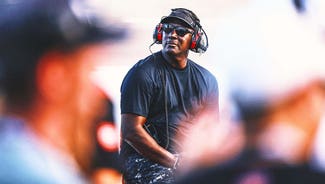
In risky sport, Danica proves she's game
Even as the ambulance passed through the infield, you had to remind yourself she was OK.
After all, you had seen her moments after impact, removing the steering wheel and tossing it in disgust. The television announcers had rendered an instant diagnosis. Danica is fine, they said.
Then again, that seemed of little comfort to her parents as they hurried past the security checkpoint. They identified themselves as the just-wrecked driver’s mother and father, but really, there was no need. The anxiety on their faces identified them clearly enough.
You don’t think of drivers as having moms and dads. It’s easier, and perfectly understandable, to consider them like characters in a video game, which is to say artfully drawn abstractions. The hazards of NASCAR racing are so visually spectacular they can’t be real. Can they?
Danica Patrick must have been going 150 mph when she hit the retaining wall. Then, from the squished radiator: a spray of droplets across the windshield. The car itself, the No. 10 GoDaddy.com Chevrolet, had been ruined beyond repair, skidding to a halt without much of a front end, a right side panel or a back bumper. No matter how many races you’ve seen, the aftermath remains both an awesome sight and a guilty pleasure. This wasn’t the latest "Fast and Furious" movie. This was real, shards of metal literally fluttering in the wind.
Once again, you reminded yourself that Patrick got out of the car on her own, that she wasn’t hurt.
Still, there was something unmistakably concussive about the impact. Even the embrace of the HANS device couldn’t prevent her head from whipping forward on impact.
Let’s not debate driver safety. NASCAR has made enormous strides in that department. Just the same, the idea that racers are safe is as counterfeit and overstated as Danica’s listed height and weight. (She says she’s 5-foot-2, 100 pounds; she’s 5 feet, 90 pounds, max.)
Danger is the sport’s fundamental attraction — and now more than ever. If this week marks the return of so-called pack racing, it’s also a celebration of what made the Great American Race great, American and fantastically perilous.
Pack racing means wrecking. To encourage one is to encourage the other. I’m not arguing there is anything terribly wrong with this. If the drivers accept the risk, I shouldn’t have much of a problem. Just understand that in acceding to the wishes of the fans — using rule changes, such as decreasing water in the radiator or cutting radio communication between cars, to stop the two-car drafting — NASCAR is calibrating the risk. It’s an inexact science. Eleven years after Dale Earnhardt Sr. died on the last lap of the Daytona 500, you can’t help but wonder whether NASCAR, as my colleague Reid Spencer put it, hasn’t been lulled into a false sense of security.
Thirty-four racers have died at Daytona since 1959, according to a Wikipedia entry, “List of Daytona International Speedway fatalities.” One of them died in a speedboat on the artificial lake in the infield. Others died riding motorcycles. Twelve were stock-car deaths. Four occurred while competing or qualifying for the 500.
The Earnhardt death — a father killed blocking for his son and his team’s driver — borders on the mythic. The intervening years haven’t produced any such fables, but they haven’t been short on moments of horrifying exhilaration, either.
In 2001, Tony Stewart wound up in the hospital. In 2003, Ryan Newman’s car was precariously balanced for several seconds on its front end, like a ballerina’s foot, on the infield grass. A year later, Michael Waltrip miraculously walked away from an upside-down car after a wreck that saw him flip three times. Four years ago, Clint Bowyer slid a good part of the last lap upside down past the finish line. His car was in flames when he got out.
This past week saw Jeff Gordon go upside down on the backstretch, his No. 24 Chevrolet looking like a prop slapped by a Godzilla-sized monster. And now, Danica Patrick, clipped by Aric Almirola on the last lap.
It was terrifying. But let me not lie, it was thrilling, too.
She was asked whether she had ever taken a harder hit.
“It felt pretty big,” she said.
How did it feel, hitting the wall like that?
“It sucks,” she said. “But you kind of brace yourself.”
Patrick had the composure to let go of the steering wheel and raise her hands just before impact. It's a technique Indy racers learn so as not to fracture their hands or arms.
Drivers aren’t physically different like, say, NBA or NFL players. What distinguishes them is psychological. You put on that firesuit, you accept the risk. It might look like hi-def special effects, but in fact, at some level, it’s life and death.
Patrick’s manner had an air of concession: “I’m just very disappointed.”
She’s tiny, and in that moment, just released from the Infield Care Center, she looked crestfallen. It sounds patronizing, maybe even sexist, to call her a brave little girl. But it’s stranger still to think she’s now one of the boys.

